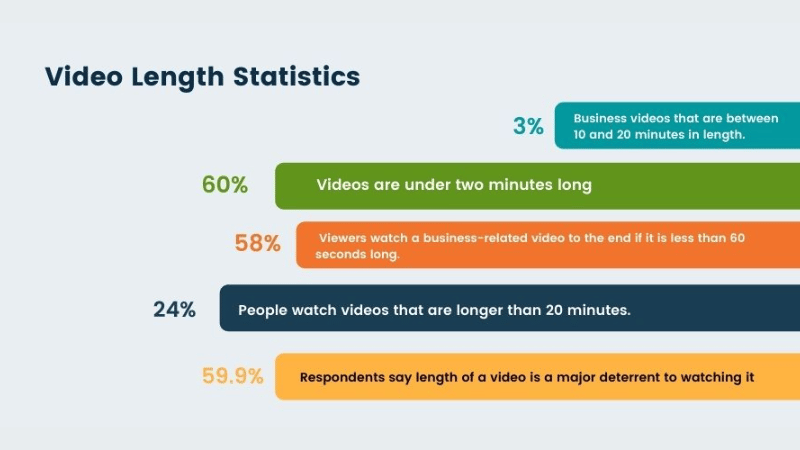Have you ever wondered how long can a Facebook ad video be to comply with the platform’s rules and still engage viewers? In reality, Facebook allows for a fairly comfortable video duration, but to retain customers, longer isn’t necessarily better. Understanding the limits and choosing an appropriate length will help your ad campaign save costs and increase effectiveness.
How long should a Facebook ad video be?
When running ads on Facebook, what should the video duration be to both ensure compliance with platform regulations and optimize effectiveness with viewers? Although Facebook allows posting very long videos, the truth is that not everyone is patient enough to watch from start to finish. Online users often scroll quickly, only stopping if the content is captivating within the first few seconds. Therefore, clearly understanding the limits of each type of ad video will help you choose the right length, avoiding the waste of production time and ad budget.

Feed, Stories, Reels – what are the limits
For ads displayed in the Facebook Feed, the platform allows videos to extend up to a maximum of 240 minutes. However, almost no one will sit through an ad video that long. In reality, for videos in the Feed, if they exceed 60 seconds, the completion rate drops sharply. The ideal length is usually around 15–30 seconds, which is just enough to convey the main message while maintaining viewer attention. If the content needs to be more detailed, you can extend it to 45–60 seconds; however, be sure to include an engaging hook right from the start.
For Stories and Reels, Facebook has much shorter limits. Videos in Stories are usually cut into 15-second segments, and you can string multiple Stories together if needed. Reels support videos up to a maximum of 60 seconds. With these two formats, viewers tend to scroll very quickly, so the more concise it is, the easier it is to go viral. The ideal length is still 15–30 seconds, and the content must be concise, visually appealing, and have an impact within the first 5 seconds. This is why many brands choose Reels Ads to “catch trends” and create a quick viral effect.
Key Considerations for In-Stream Ads
Unlike the Feed or Reels, In-Stream Ads are a type of ad that appears in the middle of a longer video that the user is watching. Because they are within the flow of content, this type of ad has its own specific regulations. The original video must be at least 1 minute long to allow In-Stream Ads to be inserted. The duration of the ad video in this format is usually limited to 5–15 seconds.
The most important point when running In-Stream Ads is that you don’t have much time for storytelling. Viewers are already focused on the video they chose, so if the ad appears and is too lengthy, they will easily skip it or become annoyed. That’s why many major brands condense their message into 6 seconds—known as bumper ads, short yet highly impactful. You need to place the most important element—such as your logo, slogan, or main offer—right from the very first second.
Additionally, Facebook also recommends that advertisers prepare multiple video versions with different durations for testing. Some campaigns will be suitable for a 6-second video, while others may need 15 seconds for a clearer explanation. By A/B testing, you will find the optimal formula for each audience segment.
Another point to note is the image and audio quality. Since In-Stream Ads interrupt the main content, if the ad video has blurry images, poor audio, or chaotic cuts, viewers will easily feel “interrupted.” Conversely, a creative ad segment with catchy audio and concise content can turn a brief 5–10 second moment into an extremely effective brand recall opportunity.
The golden length for viral Facebook ad videos
When it comes to Facebook Ads, video duration is the determining factor in whether a user stops to watch or scrolls past immediately. A campaign with great content but an overly long video easily causes viewers to abandon it, while one that’s too short may struggle to convey the full message. Therefore, finding the “golden length” for your ad video not only helps increase the completion rate but also creates an opportunity for the brand to go viral more powerfully.
Video timeframe: 15–30 seconds
The 15–30 second timeframe is consistently regarded as the “sweet spot” in the world of Facebook advertising. Concise yet sufficient for viewers to absorb the message, this duration perfectly aligns with the quick-scrolling behavior of Gen Z and Millennials. Within the first few seconds, the brand needs to deliver a key highlight—this could be a slogan, a visually striking product image, or a curiosity-inducing scenario.
The biggest advantage of a 15–30 second video is that it easily creates a sense of being fast, clean, and concise. Viewers don’t feel “pressured” to dedicate too much time to the ad. Additionally, the video completion rate at this length is significantly higher compared to videos exceeding 1 minute. Another plus is that this format fits most placements: from Feed, Stories, to Reels, ensuring the message can reach diverse user groups.
Video ads under 1 minute
In some cases, videos under 1 minute will yield higher effectiveness. This duration is long enough to tell a more complete story than 15–30 seconds, but still manages to retain viewer attention. Brands looking to utilize storytelling, introduce product features, or create short demos often choose this framework.
The strength of a video under 1 minute is that it provides just enough space to build a scenario, characters, and emotion, helping the audience connect more deeply with the brand. For users who are already interested or intending to purchase, a video lasting around 45–60 seconds can be the “closing argument” that persuades them to click the CTA.
However, to optimize this video type, you need to ensure the pacing doesn’t slow down. The visuals must be dynamic, the audio engaging, and any policy violations must be avoided. If the video is dragged out without a key highlight, it can easily be abandoned halfway through.
Longer videos – Is it worth it?
Facebook allows you to run video ads lasting several minutes or even hours. In reality, a long video is only truly beneficial when you are targeting an audience segment that already has a significant interest in the product or service. Examples include in-depth webinar introductions, product livestreams, or educational content requiring extensive explanation.
The most obvious drawback of a long video is the extremely low completion rate. The majority of Facebook users don’t spend more than a few minutes on an ad. Instead, they usually skip it after grasping the main idea. This leads to increased ad costs with disproportionate effectiveness.
Therefore, long videos should only be used in remarketing campaigns or when accurately targeting “high-quality” customers—those who are already interested and willing to invest time. Otherwise, most brands should condense their message into 15–60 seconds to both save budget and optimize results.
Key considerations to prevent your video ad from flopping
When running ads, it’s not just about how long a Facebook ad video is; the placement also matters. Each “spot” on Facebook has a different way of engaging viewers. If you know how to adjust the length, format, and content appropriately, your video will not only meet standards but also explode in performance.

Feed ads need to hold the viewer’s attention
The News Feed is where users scroll unconsciously every second, so you have less than 3 seconds to “hook” them. Don’t aim for an overly long video, as users are typically not patient enough to watch it through. The ideal length for Feed Ads is around 15–45 seconds, just enough to tell a concise story and spark curiosity for them to click and learn more.
A small tip: use catchy background music or transition effects. The stronger the initial visual, the more likely it is to make the viewer stop scrolling. Prioritize a clear message, and include the Call-to-Action (CTA) early instead of leaving the “closing argument” until the end of the video.
Stories & Reels: quick and engaging
Stories and Reels are the playground for brevity, speed, and high entertainment value. The limit for Reels is 60 seconds, while Stories display in 15-second segments. But in reality, a video length of 15–30 seconds is the sweet spot, enough to make an impression while preventing viewers from skipping.
Here, creativity is the decisive factor. You can try a trending track, fast-moving text, or a sensational headline in the caption. Gen Z particularly enjoys short, visually captivating content, so focus on one main message instead of cramming in too much information. More importantly, the logo or brand identity should appear early within the first 3 seconds to ensure viewer recall.
In-Stream: long yet effective
In-Stream Ads on Facebook are videos that run in the middle of the content a user is watching, similar to YouTube ads. With this placement, you have more room because the viewer is already “video-watching”, making them more accepting of longer ads. Facebook allows up to 15 seconds for non-skippable ads and longer for skippable ads.
A good strategy for In-Stream is to turn the video into a mini-story. You can tell a complete story lasting 30–60 seconds, as long as the pacing isn’t boring. The key is to have a strong hook to keep people watching, and the deeper the content goes, the clearer the CTA should be. With In-Stream, investing in polished content will bring significant effectiveness, especially for industries that need to thoroughly explain products or services.
Content + optimal hook
Whether you choose to run Feed, Stories, Reels, or In-Stream, the hook (the opening segment that grabs the viewer) remains the key. Statistics show that if you fail to “touch” an emotion or curiosity within the first 3–5 seconds, viewers will immediately scroll away.
The hook can be a bold question, a familiar situation with a twist, or a surprising visual. After the hook, ensure the content gets straight to the point instead of beating around the bush. Every second in the ad is valuable, so the clearer the message and the more direct the CTA, the higher the conversion rate.
Another tip: test multiple video versions. Sometimes, just changing the music, subtitles, or the opening line can make a clear difference in performance. The Facebook algorithm prioritizes videos with high views and engagement, so continuous optimization is the way to maintain the ad’s momentum.
Frequently Asked Questions
No, you should not. Each placement has different viewing behavior. A 60-second video might be suitable for In-Stream, but when placed in Stories, it is almost guaranteed to be skipped after a few seconds. The smart solution is to produce the same content idea but cut it into different duration versions to “fit” each placement.
No, but they can struggle to convey the full message. With a very short video, you can only generate brand awareness or introduce a product extremely quickly. To close sales or direct users to a specific Call-to-Action (CTA), the 15–30 second duration is still more optimal. However, if your product is already viral (e.g., trending snacks, beverages), a short clip under 10 seconds can be highly effective.